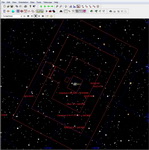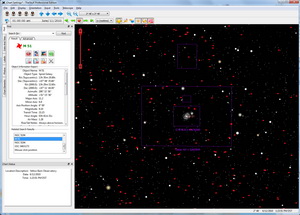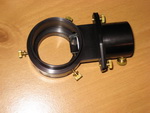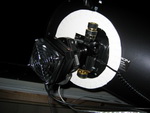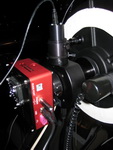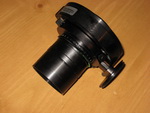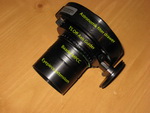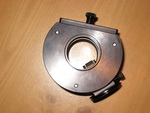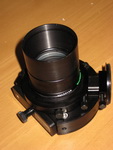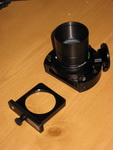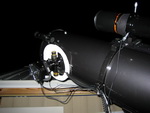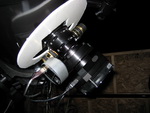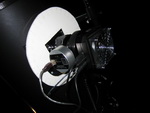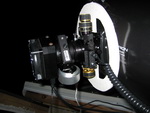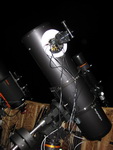Imaging Equipment - Off-axis Guiders
I started imaging without any guiding at all - with short exposures and Meade DSI. Then I shifted to guiding through a piggybacked refractor - Celestron C80ED. In this configuration I am able to get up to 5-6 minutes exposures that are good, with no elongated stars etc. Unfortunately a piggybacked setup consists of two independent scopes, and they may move independently if the support is not rigid enough. Truth is they always do move, regardless of how rigid is the connection, and it is the famous "differential flexure". The orientation of the scopes change as they track and gravity acts at different angles flexing system a bit. However, the movement may be small enough not to show on sub exposures that are not too long.
The easiest way to recognize a flexure problem
is to evaluate a long series of exposures - if the image is shifting
gradually in approximately the same direction direction all the time
there is a differential flexure problem. If the degree of flexure shift
is small enough not to show as a star elongation on the sub exposures it
is OK, but above certain exposure length it will show ... It is actually
a good idea to find out what is the longest exposure possible without
flexure problem - many people spent lots of time trying to eliminate
star elongation by improving guiding while they should have worked on
flexure
![]() - or accept
the maximum exposure time achievable with piggybacked guiding.
It is possible to compute the average speed of flexure (in pixels per
minute) from the long series (total pixel displacement divided by time)
and then compute how long does it take to move 1 pixel (or whatever is
the acceptable star elongation threshold) - and this is the maximum
piggybacked exposure.
- or accept
the maximum exposure time achievable with piggybacked guiding.
It is possible to compute the average speed of flexure (in pixels per
minute) from the long series (total pixel displacement divided by time)
and then compute how long does it take to move 1 pixel (or whatever is
the acceptable star elongation threshold) - and this is the maximum
piggybacked exposure.
Off-axis guiders (OAGs) pick a side part of light beam from the main scope (using a prism) that do not fall on the imaging sensor and use it to guide the exposures. It eliminates the flexure, but now guiding image is at the same focal length as the main scope, and the stars may be much fainter than through a piggybacked refractor. Also, the guiding FOV is now much smaller. Finding appropriate guiding star for an off-axis guider requires careful planning. I programmed all my off-axis guiders' FOVs into TheSkySix and I always find an optimal OAG orientation as apart of imaging session planning, see screenshot below. I have also attached a graduated circle around each scope's camera attachment marked every 10º, this way I don't need to guess the angle.
All good OAGs should allow to position any filters behind the pickup prism, otherwise it will be impossible to find guiding stars when doing narrowband imaging. Some OAGs have relatively fixed length of the off-axis light path, like Lumicon Easy Guider for Newtonian (second picture above). It will cause problems in some configurations when main optical path length is otherwise restricted, for example by use of a corrector or reducer. My first OAG was supposed to work with Orion 10" Newtonian. This scope requires a coma corrector, placed in the front of the guider - otherwise it is not possible to focus it at all. But MPCC corrector must be exactly 55mm from the sensor, restricting the length of the main light path. It was not possible to focus guiding camera with the Lumicon OAG in this configuration, off-axis camera holder was just too long. The best is to have OAG with a T-thread adapter just at the end of the prism arm - like a very low profile OAG from a German company Teleskop Service called TS Off-Axis Guider (TSOAG), available in the US from Teton Telescopes. It is only 9mm thick and can be easily configured with appropriate adapters to accept MPCC on the one side and Astronomik filter drawer on the other side, as shown below.
TS OAG works perfectly with Orion 10" Newtonian and is a part of my standard imaging setup now. The price for the very low profile is a limited radial movement of the prism. Lumicon OAG allows smooth radial movement of the prism, while TS OAG can only position the prism in 3 orientations, 120º apart, and one needs to disassemble it in order to change positions. It is not a big problem, I can always rotate the whole assembly, and in all cases so far it was never necessary. Orion 10" has a low focal ratio of f4.5, and the field of view of OAG (with Orion StarShoot Autoguider) is quite big and stars are reasonably bright, and there are no problems locating a good guiding star. C14 at f8.8 is a completely different story ...
Recently I started imaging with off-axis guider on C14: Orion SteadyStar. This is a much more complicated system designed for a fast guiding corrections and is discussed in adaptive optics section. I have also used Lumicon Giant Easy Guider (GEG) for C14, but only as a focal reducer, not as an off-axis guider.
